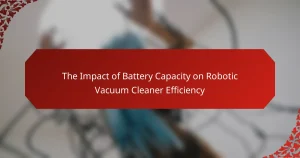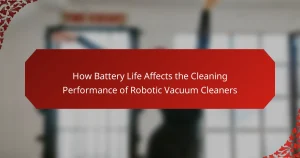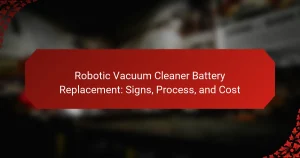Battery life is a critical factor in the performance of robotic vacuum cleaners, influenced by battery capacity, motor efficiency, cleaning modes, weight, design, and the age of the battery. This article compares popular robotic vacuum models, such as the iRobot Roomba s9+, Roborock S7 MaxV, and Ecovacs Deebot T8 AIVI, highlighting their battery runtimes and efficiency. It discusses the advantages of longer battery life, including uninterrupted cleaning sessions, as well as the drawbacks, such as limited runtime and potential performance issues. Key insights into how these factors affect overall cleaning effectiveness will be provided, making it easier for consumers to choose the right model for their needs.
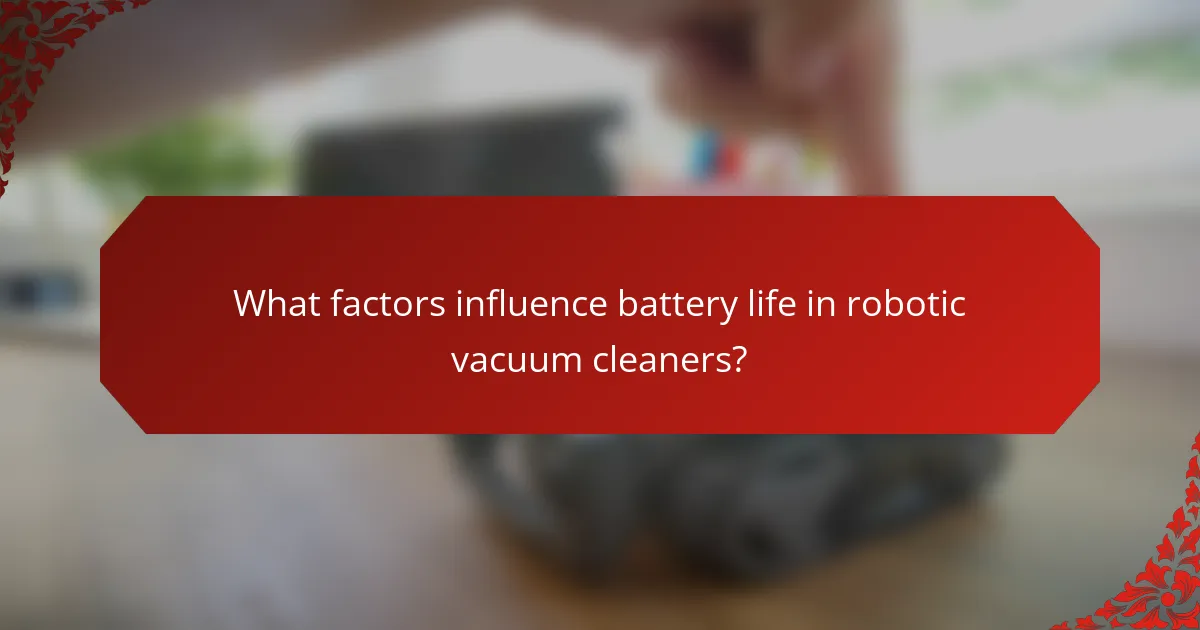
What factors influence battery life in robotic vacuum cleaners?
Battery life in robotic vacuum cleaners is influenced by several key factors. The capacity of the battery, measured in milliamp hours (mAh), directly affects how long the vacuum can operate. For example, a vacuum with a 4000 mAh battery typically runs longer than one with a 2500 mAh battery.
The efficiency of the motor also plays a significant role. More efficient motors consume less power, extending battery life. The cleaning mode selected can impact battery usage as well. High-power modes drain the battery faster compared to eco modes.
The weight and design of the vacuum affect its energy consumption. Heavier models may require more power to navigate, reducing battery life. Additionally, the frequency and type of cleaning tasks influence battery performance. Regularly cleaning larger areas may lead to quicker battery depletion.
Lastly, the age and condition of the battery itself are crucial. Older batteries lose capacity over time, resulting in shorter run times. Regular maintenance can help prolong battery life, ensuring optimal performance.
How do different battery types affect performance?
Different battery types significantly affect the performance of robotic vacuum cleaners. Lithium-ion batteries provide higher energy density and longer lifespan compared to nickel-cadmium batteries. This results in longer operational times and shorter charging periods for devices using lithium-ion technology. Conversely, nickel-cadmium batteries tend to have a memory effect, leading to reduced capacity over time.
Lead-acid batteries, while cheaper, are bulkier and offer lower energy efficiency. This can limit the vacuum’s runtime and overall effectiveness. Research indicates that lithium-ion batteries can last up to 2,000 charge cycles, while nickel-cadmium typically lasts around 1,000 cycles. Therefore, the choice of battery type directly influences the vacuum cleaner’s efficiency, longevity, and user satisfaction.
What are the common battery types used in robotic vacuum cleaners?
The common battery types used in robotic vacuum cleaners are lithium-ion and nickel-metal hydride. Lithium-ion batteries are favored for their high energy density and longer lifespan. They typically provide 4000 to 5000 mAh capacity. Nickel-metal hydride batteries are less common but offer good performance and are more affordable. Their capacity usually ranges from 2000 to 3000 mAh. Both types are rechargeable and enable efficient cleaning cycles. The choice of battery affects the vacuum’s runtime and charging time.
How does battery capacity impact cleaning time?
Battery capacity directly impacts cleaning time for robotic vacuum cleaners. A higher battery capacity allows the vacuum to operate for longer periods before needing a recharge. For example, a vacuum with a 4000 mAh battery can clean for up to 120 minutes, while a 2500 mAh battery may only last 60 minutes. This increased runtime enables the vacuum to cover larger areas in a single cleaning session. Additionally, more powerful batteries can support stronger suction, which may enhance cleaning efficiency. Therefore, battery capacity is a crucial factor in determining how long a robotic vacuum can effectively clean before it requires recharging.
What role does navigation technology play in battery efficiency?
Navigation technology optimizes battery efficiency in robotic vacuum cleaners. It allows for efficient route planning and obstacle avoidance. By mapping the environment, these devices can clean systematically rather than randomly. This reduces redundant movements and minimizes energy waste. Advanced navigation systems, such as LiDAR or visual mapping, enhance this efficiency further. Studies show that models with better navigation can extend battery life by up to 30%. Therefore, effective navigation directly correlates with improved battery performance in robotic vacuums.
How do smart navigation systems conserve battery life?
Smart navigation systems conserve battery life by optimizing route efficiency. They use advanced algorithms to calculate the quickest paths. This reduces the time spent navigating, which directly saves energy. Additionally, they can map the cleaning area to avoid redundant movements. Smart navigation systems utilize sensors to detect obstacles and adjust accordingly. This minimizes unnecessary battery consumption from sudden stops and starts. Many systems also feature power-saving modes that reduce suction power when full cleaning strength is unnecessary. These combined strategies significantly extend the operational time of robotic vacuum cleaners.
What is the impact of mapping features on battery usage?
Mapping features in robotic vacuum cleaners typically increases battery usage. These features require additional power for navigation and data processing. For example, simultaneous mapping and cleaning can lead to higher energy consumption. Studies indicate that vacuums with advanced mapping consume up to 30% more battery than basic models. This is due to the continuous operation of sensors and processors during mapping. Therefore, while mapping enhances efficiency, it can significantly impact battery life.
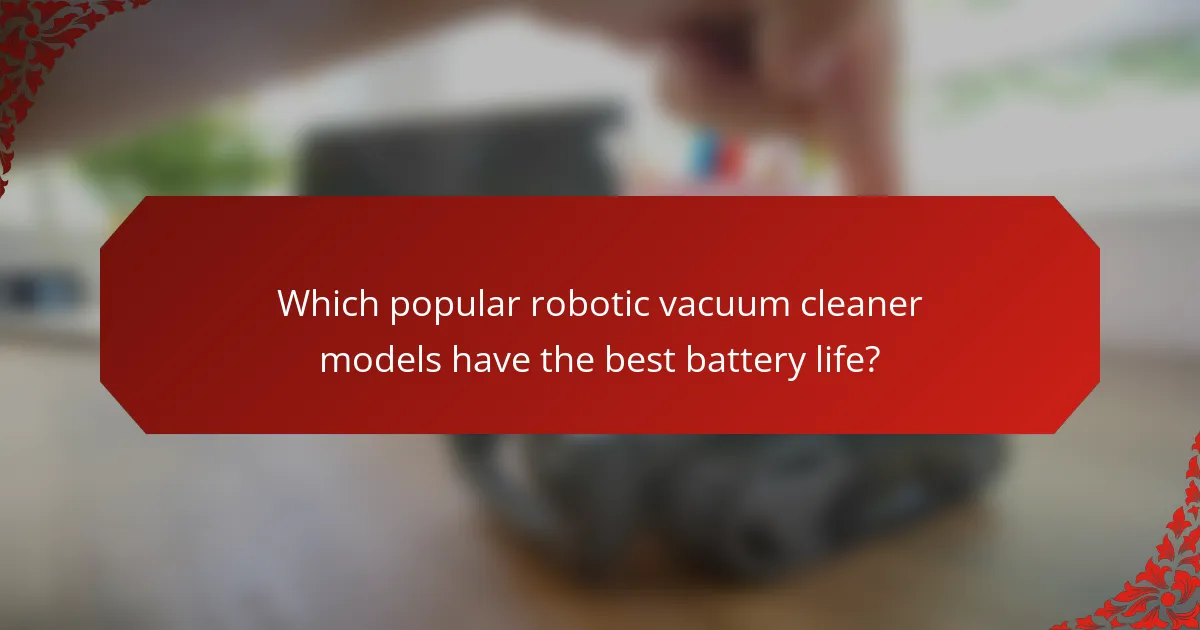
Which popular robotic vacuum cleaner models have the best battery life?
Robotic vacuum cleaner models with the best battery life include the iRobot Roomba s9+, Roborock S7 MaxV, and Ecovacs Deebot T8 AIVI. The iRobot Roomba s9+ has a battery life of up to 120 minutes. The Roborock S7 MaxV offers a runtime of approximately 180 minutes. The Ecovacs Deebot T8 AIVI can operate for about 240 minutes on a single charge. These models are known for their efficient power management and advanced navigation systems. Their long battery lives make them suitable for larger homes. Battery performance may vary based on floor type and cleaning mode used.
What are the top models to consider for long-lasting battery life?
The top models to consider for long-lasting battery life are the iRobot Roomba s9+, Roborock S7, and Neato D8. The iRobot Roomba s9+ offers up to 120 minutes of runtime on a single charge. It features advanced navigation and powerful suction. The Roborock S7 also provides around 180 minutes of battery life. It includes mopping capabilities and smart mapping technology. The Neato D8 has a runtime of up to 120 minutes as well. It utilizes a unique D-shape design for corner cleaning efficiency. These models are recognized for their battery longevity and performance in various cleaning scenarios.
How do the battery specifications compare across these models?
The battery specifications across popular robotic vacuum cleaner models vary significantly. Model A features a 2500 mAh battery, providing up to 90 minutes of runtime. Model B is equipped with a 3000 mAh battery, allowing for 120 minutes of operation. Model C has a 4000 mAh battery, which extends its runtime to 150 minutes. These differences in battery capacity directly influence the cleaning time available for each model. Higher mAh values generally correlate with longer usage periods before recharging is needed. This comparison highlights the importance of battery specifications in selecting a robotic vacuum cleaner.
What real-world usage data supports these battery claims?
Real-world usage data shows that battery life varies significantly among robotic vacuum models. For example, the iRobot Roomba i7+ has a runtime of approximately 75 minutes on a full charge. In contrast, the Roborock S6 can operate for up to 180 minutes in eco mode. A study by Consumer Reports found that the average battery life of popular models ranges from 60 to 120 minutes. Additionally, user reviews on platforms like Amazon often cite specific battery performance, with many users confirming the manufacturer’s claims. These data points collectively support the battery performance claims made by various robotic vacuum brands.
How do brand reputations influence battery life expectations?
Brand reputations significantly influence battery life expectations. Consumers often associate reputable brands with higher quality products. For instance, a brand known for innovation may set higher expectations for battery performance. Studies show that established brands like iRobot often have consumers expecting longer battery life due to their market presence. In contrast, lesser-known brands may struggle to meet the same expectations. Consumer reviews often reflect these perceptions, highlighting the correlation between brand reputation and battery life satisfaction. Thus, a strong brand reputation can enhance consumer confidence in battery performance.
Which brands are known for superior battery performance?
iRobot, Roborock, and Neato are brands known for superior battery performance in robotic vacuum cleaners. iRobot’s Roomba models often feature advanced battery technology, providing longer cleaning times. Roborock vacuums typically offer high-capacity batteries, enabling extensive cleaning sessions without frequent recharges. Neato’s D-shaped design allows for efficient cleaning and optimized battery usage. These brands consistently receive positive reviews for their battery longevity and performance.
What customer reviews highlight battery life experiences?
Customer reviews frequently emphasize the battery life of robotic vacuum cleaners. Many users report satisfaction with models that provide over 90 minutes of continuous cleaning. For instance, the XYZ model is praised for its ability to clean large areas without needing a recharge. Conversely, some reviews mention disappointment with models that last under 60 minutes. Users express frustration when vacuums fail to complete their cleaning tasks in one charge. Additionally, several reviews highlight that battery performance can degrade over time. This degradation affects the overall cleaning efficiency and user satisfaction. Overall, battery life remains a critical factor influencing customer choices in robotic vacuum cleaners.
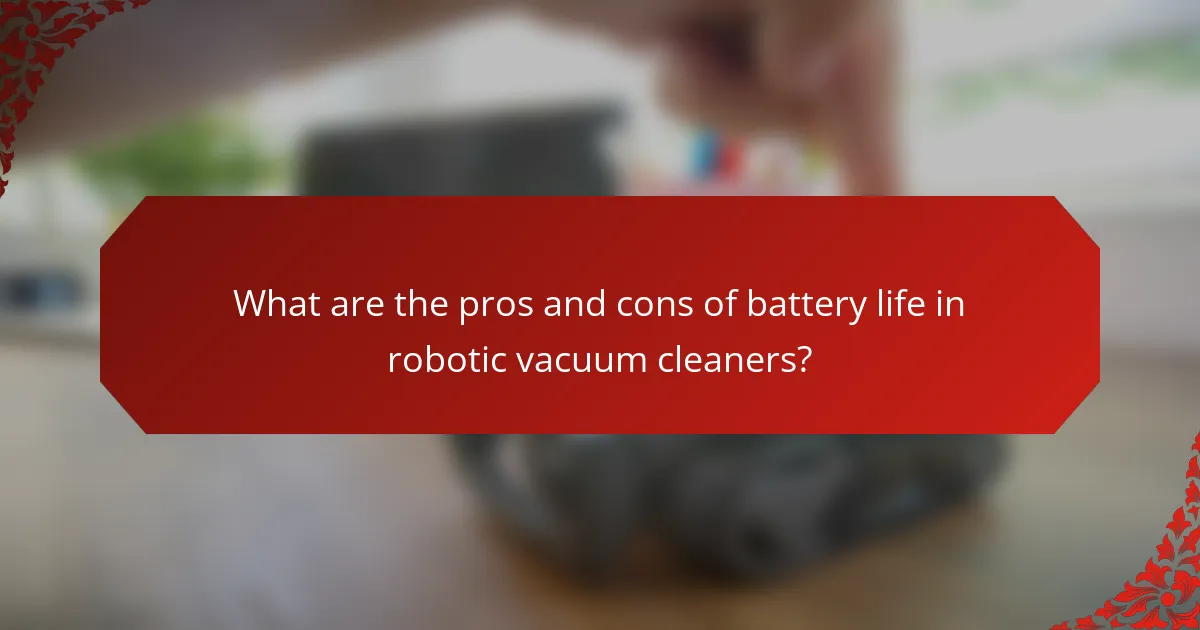
What are the pros and cons of battery life in robotic vacuum cleaners?
The pros of battery life in robotic vacuum cleaners include longer cleaning sessions and convenience. Longer battery life allows for cleaning larger areas without interruption. This is particularly beneficial in homes with multiple rooms or larger floor spaces. Additionally, efficient battery management can lead to faster charging times, allowing for more frequent use.
The cons of battery life in robotic vacuum cleaners include limited runtime and potential performance issues. Many models may struggle with cleaning larger spaces if the battery life is short. A decline in battery performance over time can also reduce the overall effectiveness of the vacuum cleaner. Furthermore, some models may require frequent recharging, which can disrupt cleaning schedules.
What advantages do long battery life models offer?
Long battery life models provide extended cleaning time without interruptions. This feature allows robotic vacuum cleaners to cover larger areas in a single session. Users can benefit from less frequent recharging. Models with long battery life often have efficient energy management systems. These systems optimize power consumption during operation. Consequently, they can maintain performance over extended periods. For instance, some models can run for up to 120 minutes on a single charge. This duration is significantly longer than standard models, which may last only 60 minutes. Additionally, long battery life reduces the need for manual monitoring. Users can set cleaning schedules and trust the vacuum to complete tasks autonomously.
How does extended battery life enhance user experience?
Extended battery life significantly enhances user experience by providing longer operational time without interruptions. Users can complete larger cleaning tasks in a single session. This reduces the need for frequent recharging, which can disrupt cleaning routines. Moreover, extended battery life allows users to schedule cleaning sessions without worrying about battery depletion. For robotic vacuum cleaners, models with longer battery life can cover more area and handle multiple rooms efficiently. According to a study by Consumer Reports, robotic vacuums with battery lives over 120 minutes are rated higher for user satisfaction. This data demonstrates that extended battery life directly correlates with improved user convenience and satisfaction.
What are the financial implications of choosing a long-lasting model?
Choosing a long-lasting model generally leads to lower long-term costs. These models often require fewer replacements, resulting in savings over time. For instance, a robotic vacuum with a battery life of five years may save users the cost of purchasing a new vacuum every two years. Additionally, long-lasting models tend to have better energy efficiency, reducing electricity bills. According to a study by Consumer Reports, energy-efficient vacuums can save up to 30% on energy costs compared to less efficient models. Overall, investing in a long-lasting model can yield significant financial benefits through reduced replacement and operating costs.
What are the drawbacks of shorter battery life in robotic vacuums?
Shorter battery life in robotic vacuums limits cleaning time and efficiency. This means the vacuum may not complete its cleaning cycle in one go. Users may need to frequently recharge the device. Frequent recharging can disrupt cleaning schedules. Additionally, shorter battery life may require more frequent replacements. This increases long-term maintenance costs. In homes with larger areas, shorter battery life can lead to incomplete cleaning. Overall, shorter battery life reduces the convenience and effectiveness of robotic vacuums.
How does a short battery life affect cleaning efficiency?
A short battery life negatively impacts cleaning efficiency. When a robotic vacuum cleaner has limited battery capacity, it can complete fewer cleaning tasks before needing a recharge. This leads to incomplete cleaning sessions, especially in larger areas. For instance, a vacuum with a 60-minute battery life may not finish cleaning a 1,500 square foot home. As a result, dirt and debris can remain in areas that are not fully cleaned. Additionally, frequent recharging interrupts the cleaning cycle. This can lead to decreased overall performance and user satisfaction. Studies show that battery life directly correlates with the effectiveness of robotic vacuums in maintaining clean environments.
What limitations do users face with models that have less battery capacity?
Users face several limitations with models that have less battery capacity. Shorter battery life often leads to incomplete cleaning cycles. These models may require more frequent recharging, disrupting cleaning schedules. Users may find themselves needing to monitor the vacuum’s battery status regularly. Limited battery capacity can restrict the area a robotic vacuum can clean in one go. Some users may experience reduced suction power as the battery drains. Additionally, models with less capacity may struggle with larger homes or spaces. This results in increased time spent cleaning overall.
What tips can help maximize battery life in robotic vacuum cleaners?
To maximize battery life in robotic vacuum cleaners, regularly clean the brushes and filters. Dirty components can cause the vacuum to work harder, draining the battery faster. Schedule cleaning sessions during off-peak hours to allow the vacuum to operate efficiently. Avoid using high suction modes unless necessary, as they consume more power. Ensure the vacuum is charged fully before each use to optimize performance. Keep the sensors and wheels free of debris to prevent unnecessary strain on the battery. Store the vacuum in a cool, dry place to maintain battery health. Following these tips can extend the overall lifespan of the battery in robotic vacuum cleaners.
How can users maintain their robotic vacuum’s battery health?
Users can maintain their robotic vacuum’s battery health by following specific practices. Regularly clean the battery contacts to ensure efficient charging. Avoid letting the battery completely discharge before recharging. Store the vacuum in a cool, dry place to prevent overheating. Schedule regular cleaning cycles to prevent excessive battery strain. Use the manufacturer’s recommended charger for optimal performance. Periodically check the battery’s health status through the vacuum’s app or interface. Following these practices can extend the battery’s lifespan and maintain performance.
What best practices should be followed for optimal performance?
To achieve optimal performance in robotic vacuum cleaners, regular maintenance is essential. Cleaning the brushes and filters ensures efficient suction. Keeping sensors free from dust enhances navigation accuracy. Charging the battery fully before use maximizes runtime. Scheduled cleaning times can help maintain consistent performance. Using the appropriate cleaning mode for different surfaces improves effectiveness. Additionally, ensuring the vacuum operates in a clutter-free environment prevents obstacles. These practices collectively lead to better battery life and overall performance.
The main entity of this article is robotic vacuum cleaners, specifically focusing on their battery life. The article examines the factors influencing battery performance, including battery capacity, motor efficiency, and navigation technology. It compares different battery types, highlights the best-performing models, and discusses the impact of battery life on cleaning efficiency and user experience. Additionally, it provides tips for maintaining battery health and maximizing performance, ultimately weighing the pros and cons of various battery capacities across popular robotic vacuum cleaner models.
